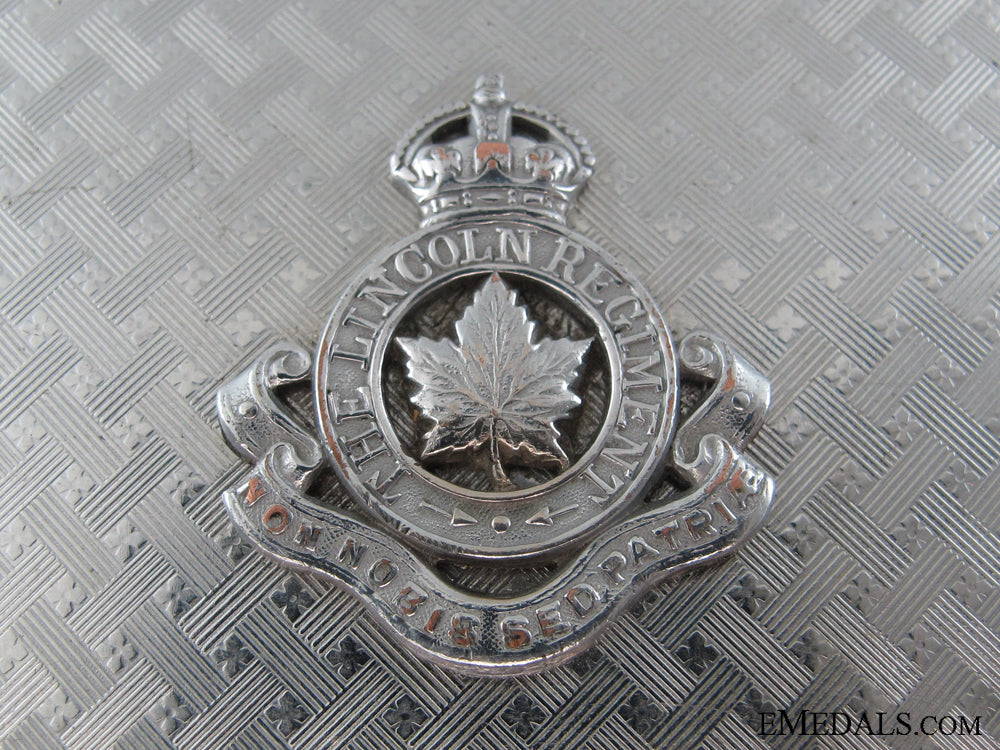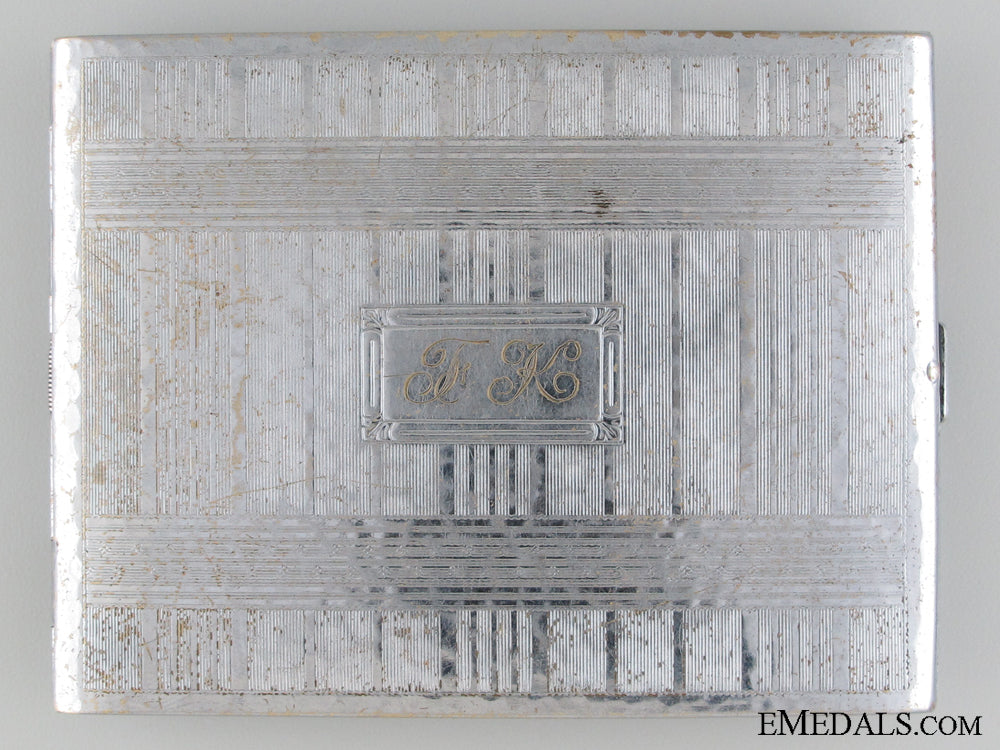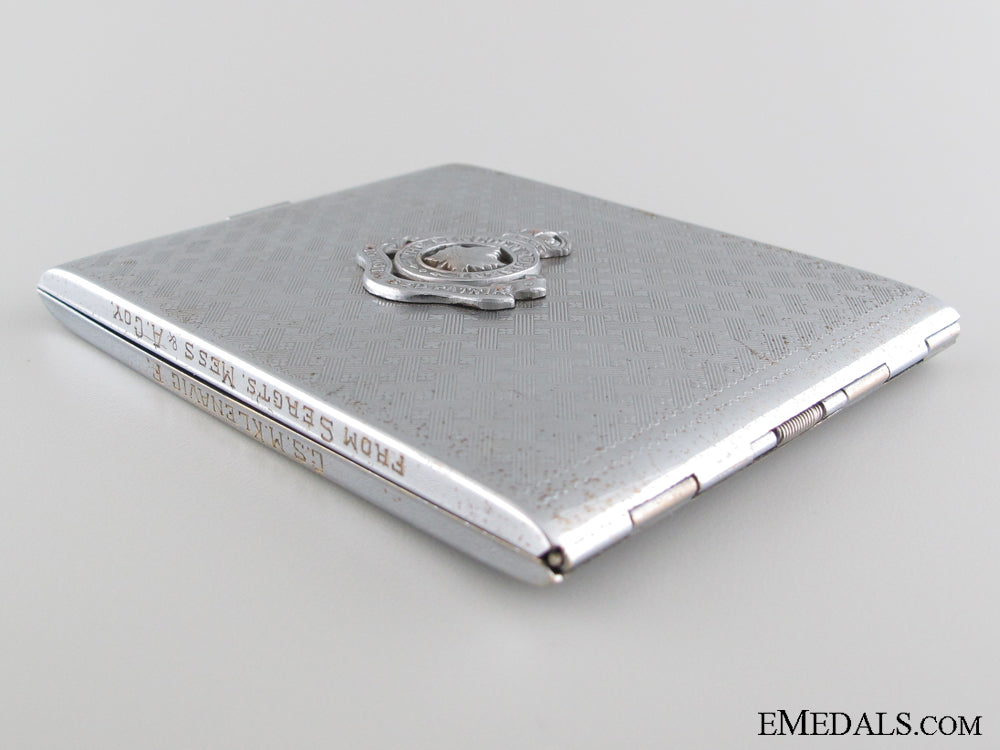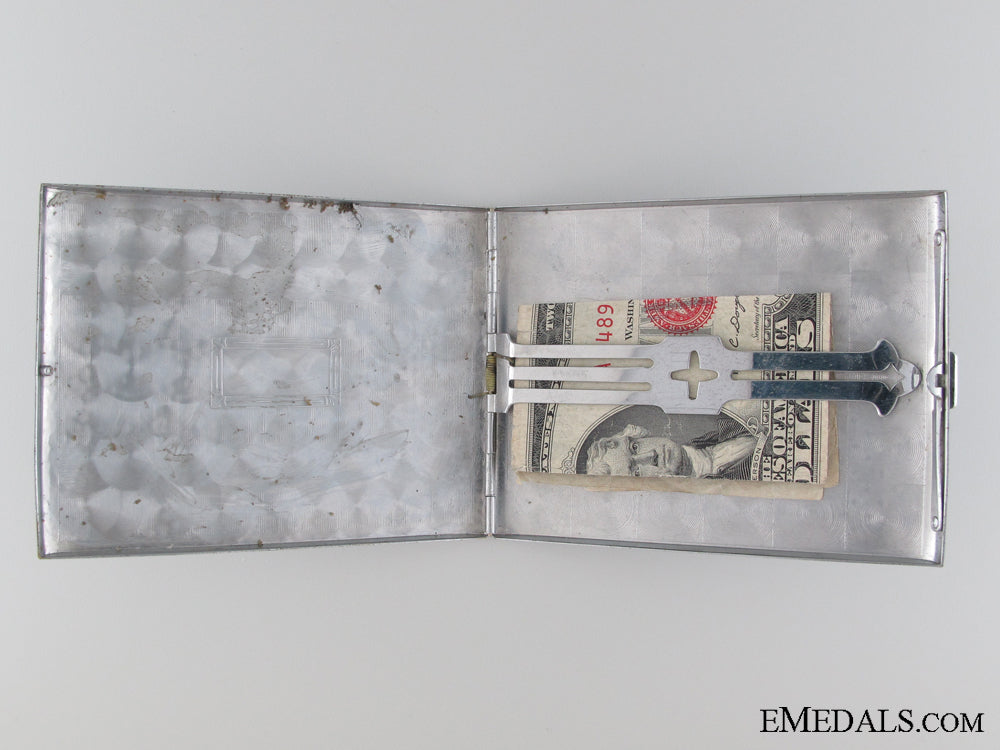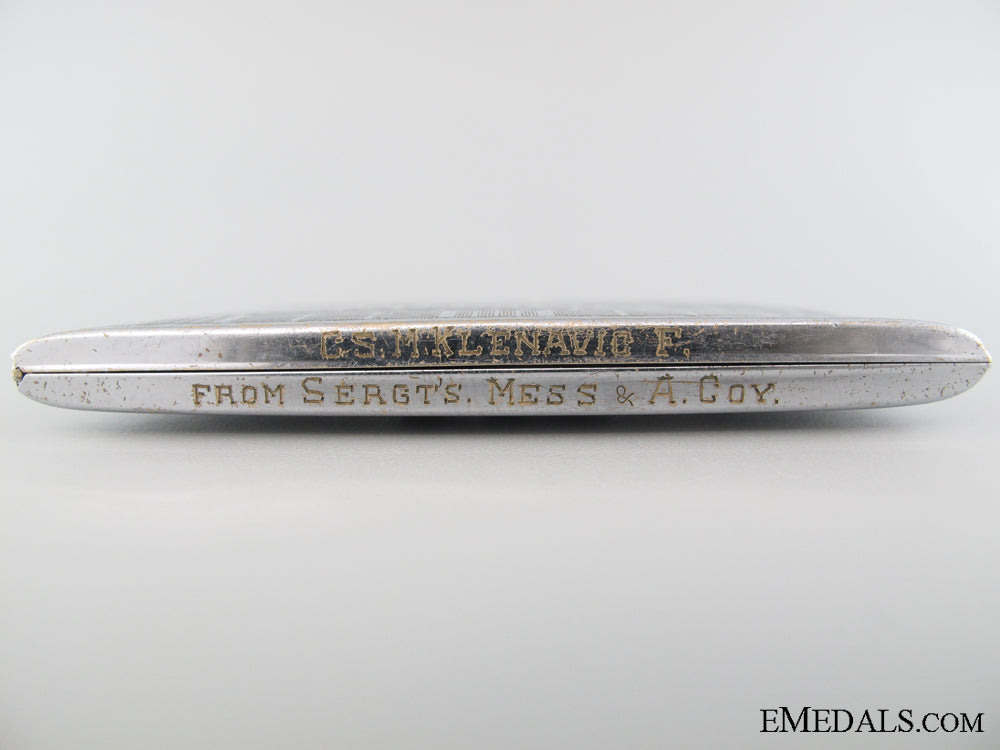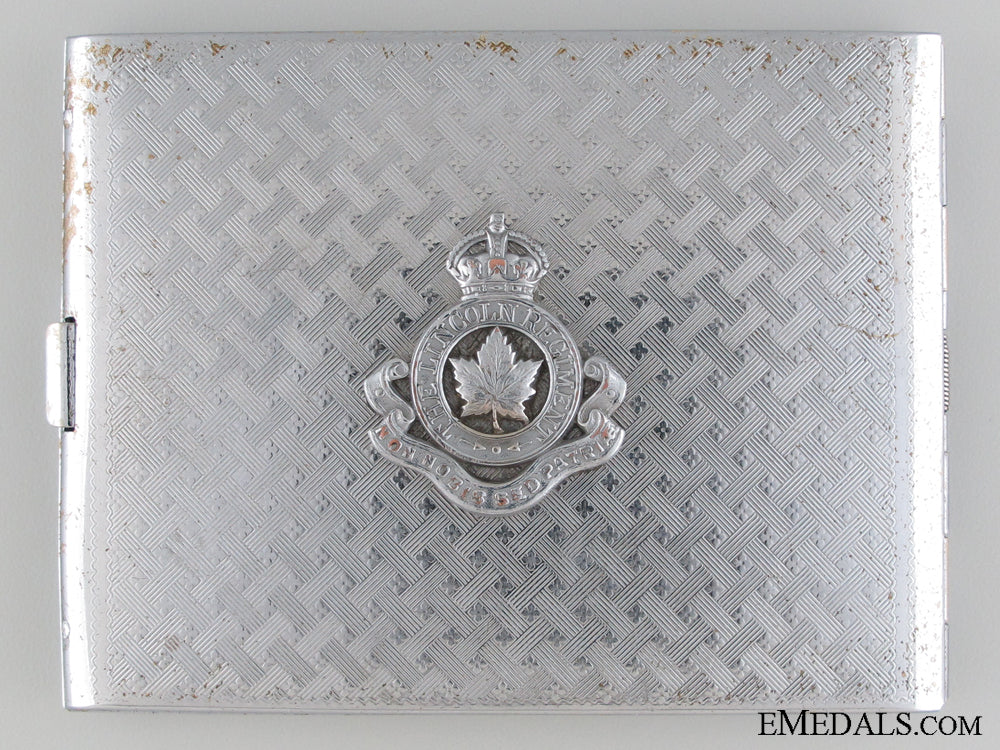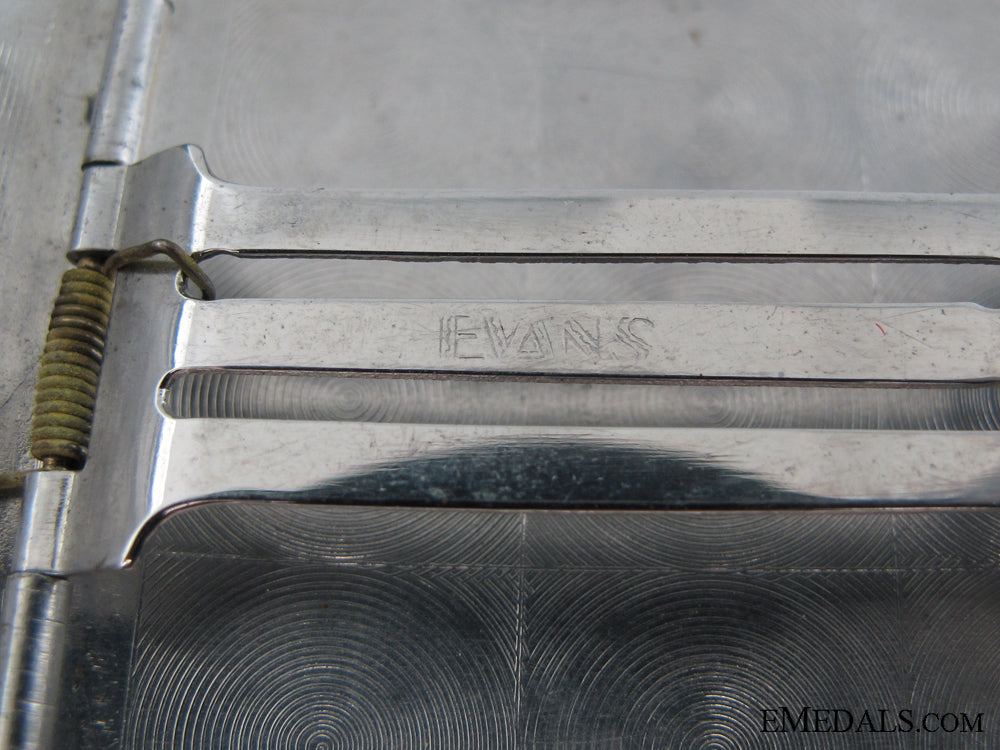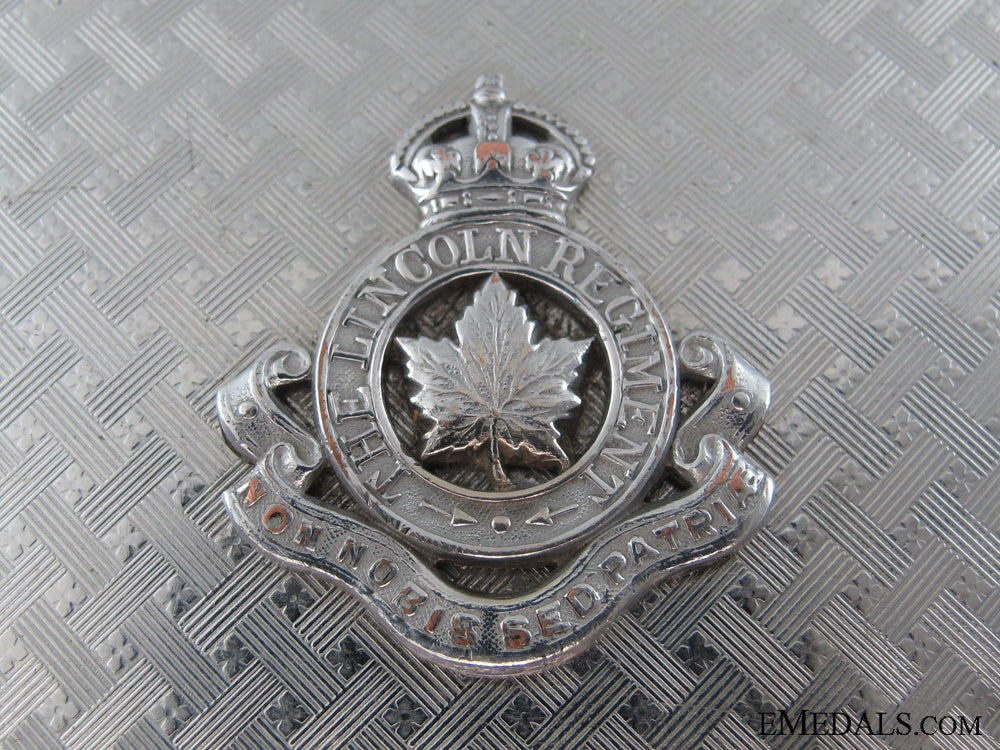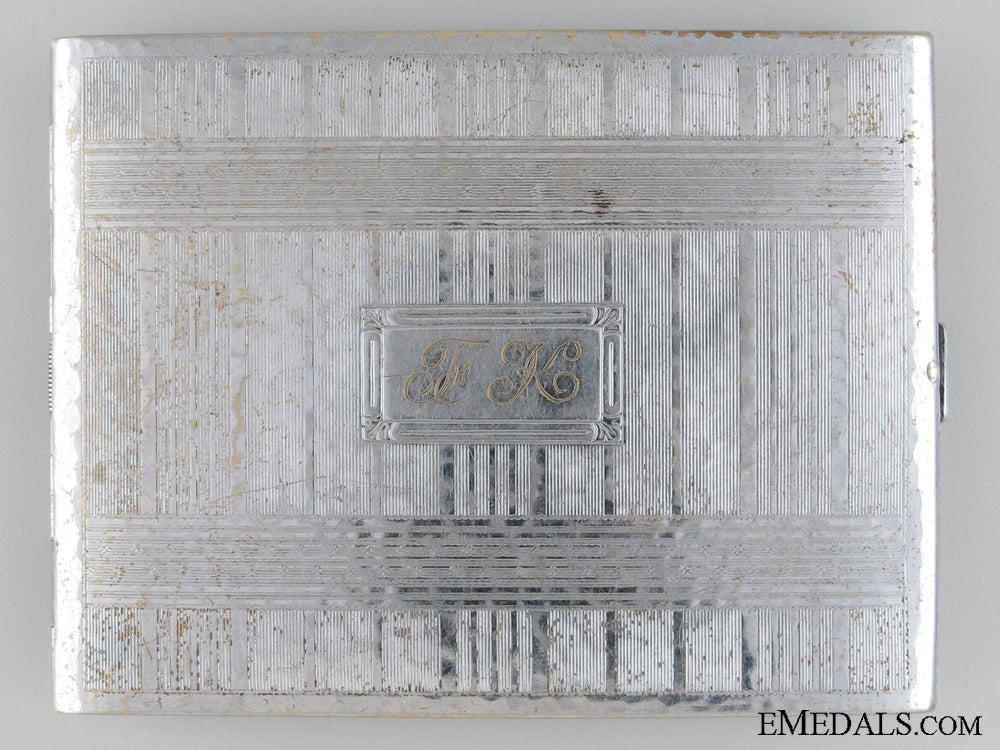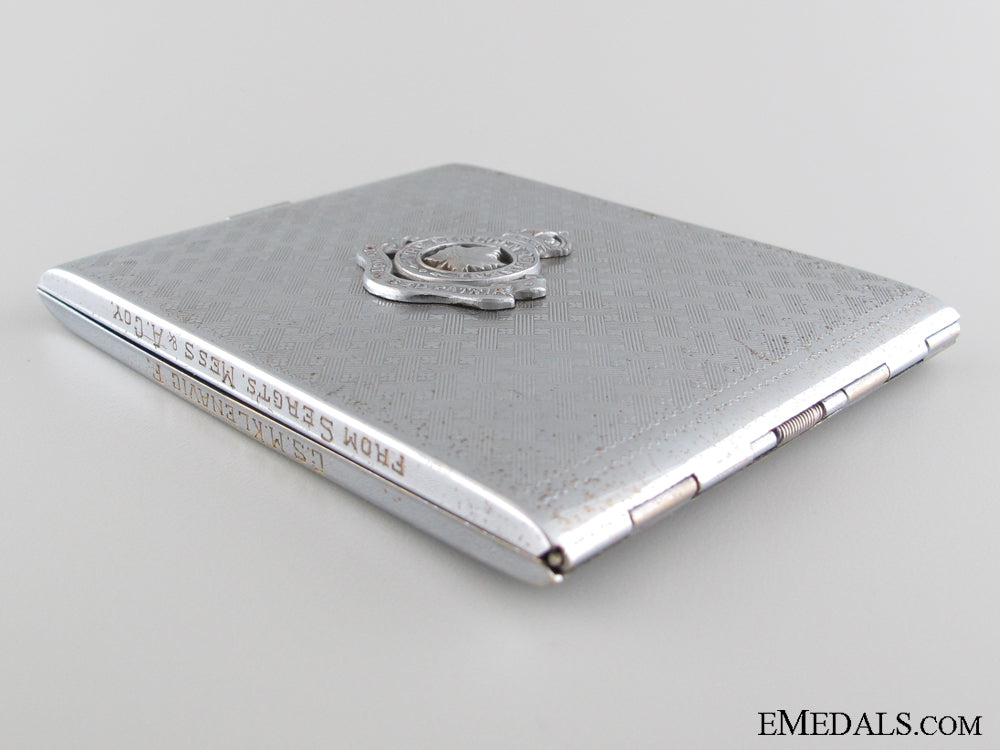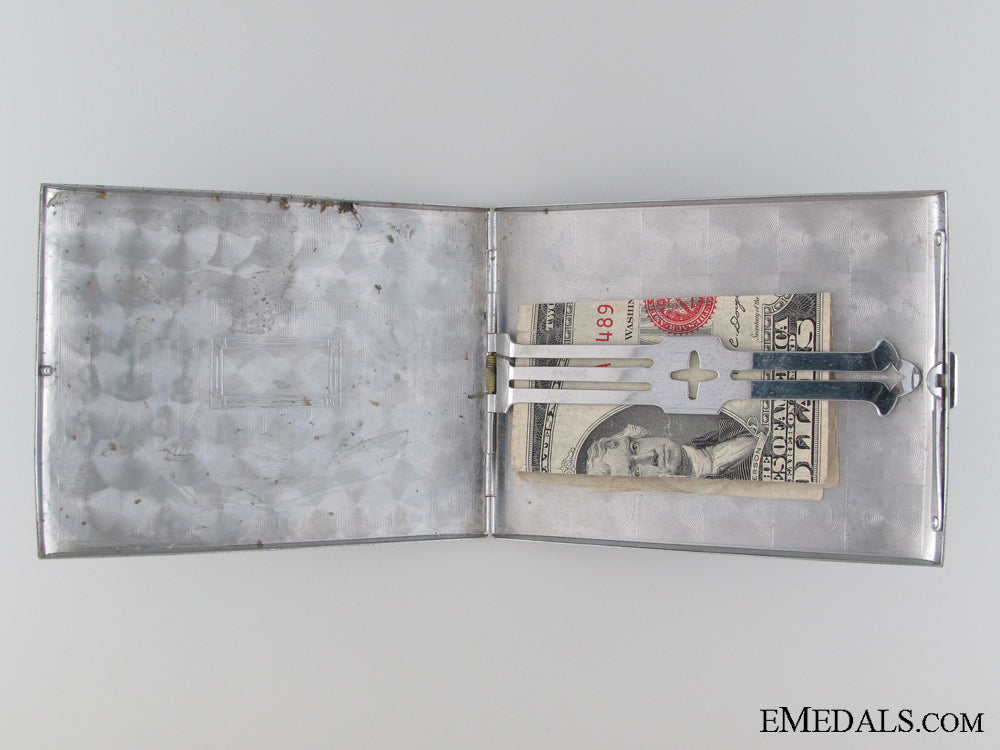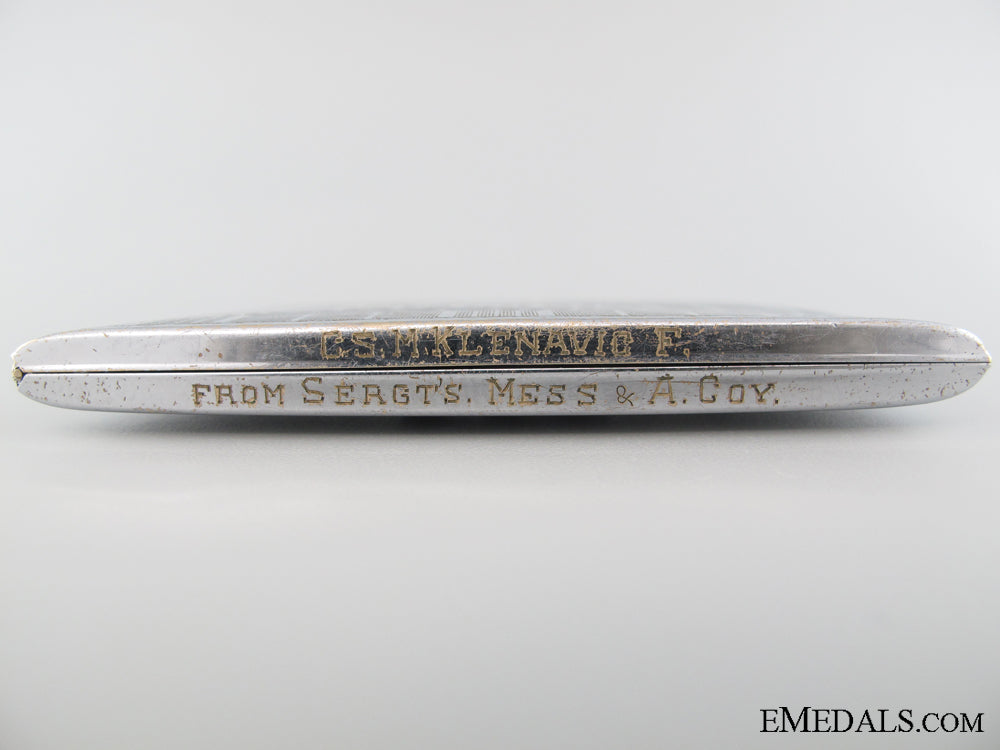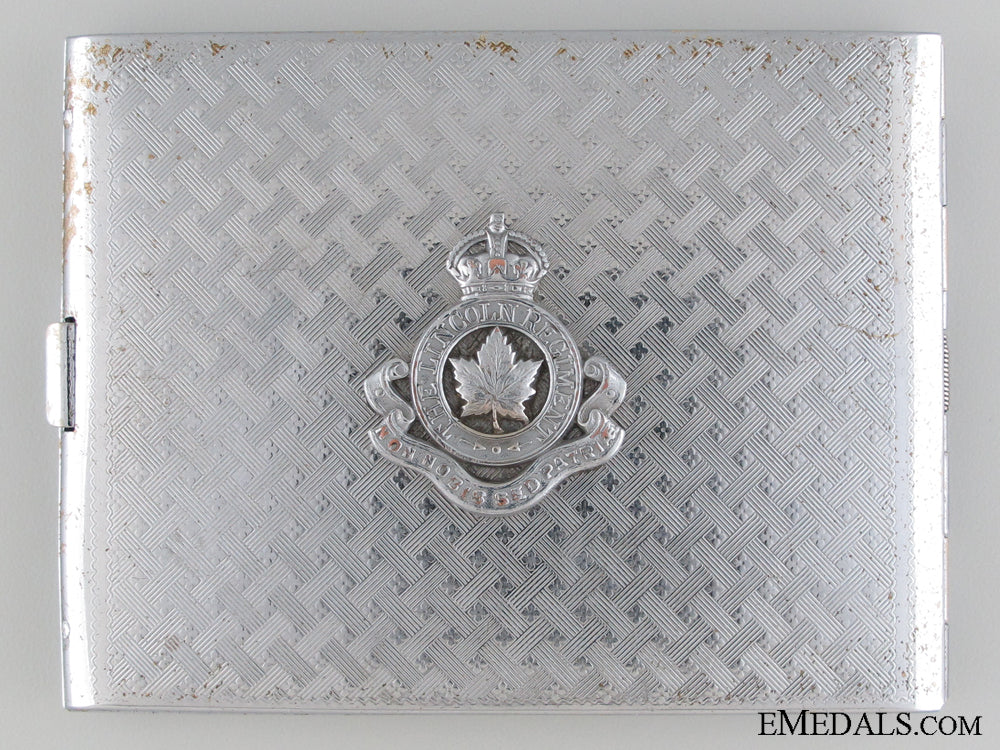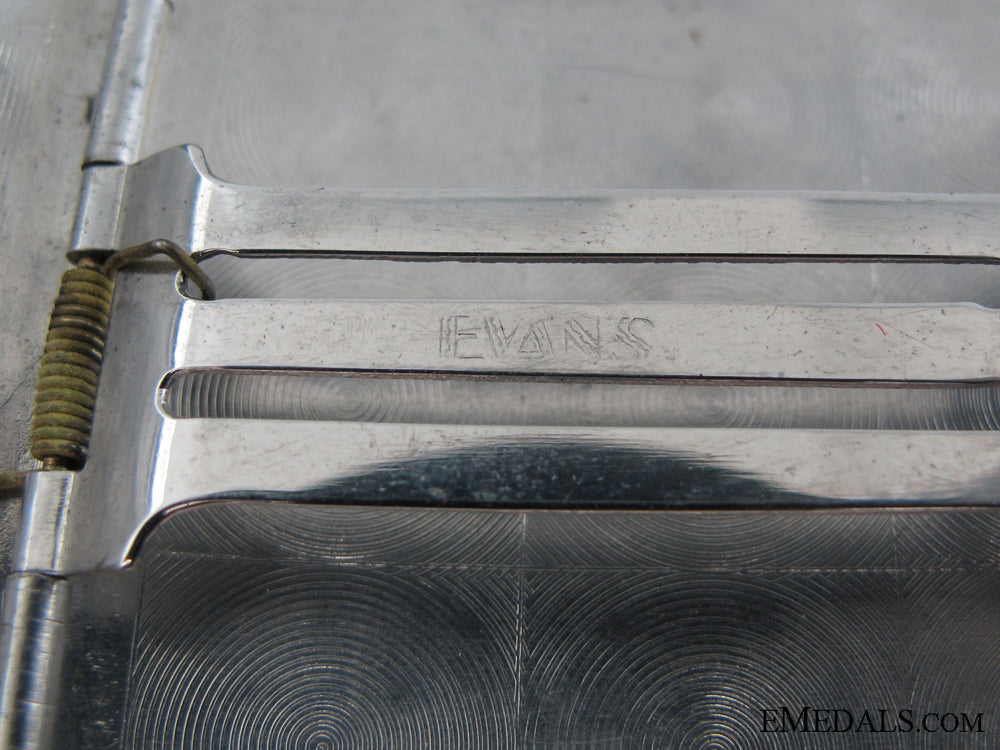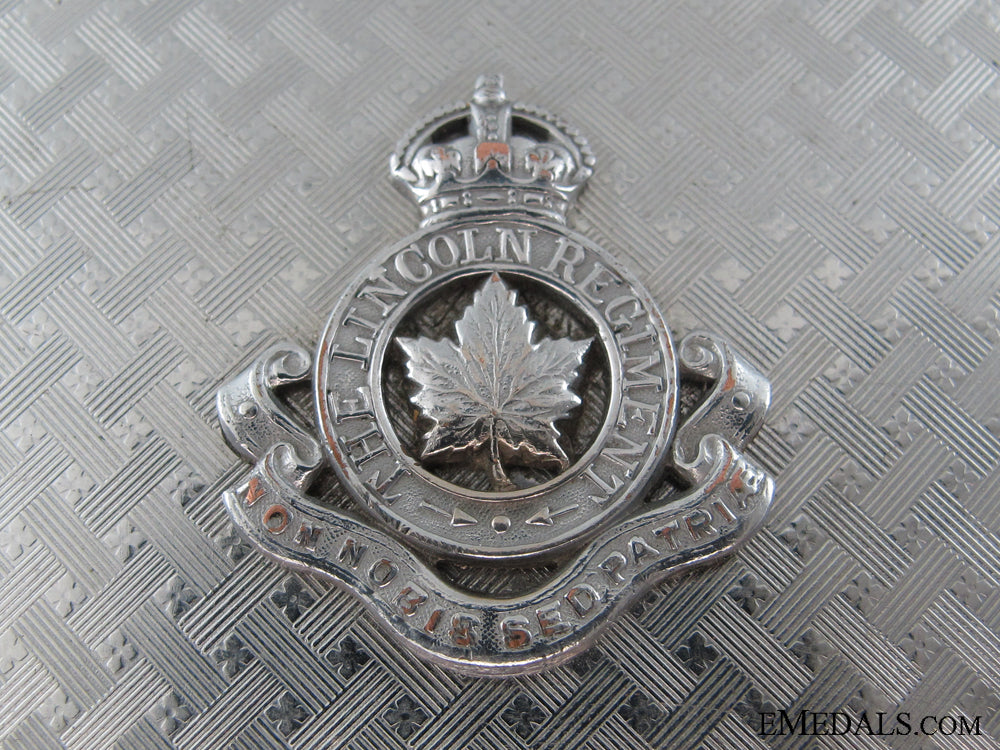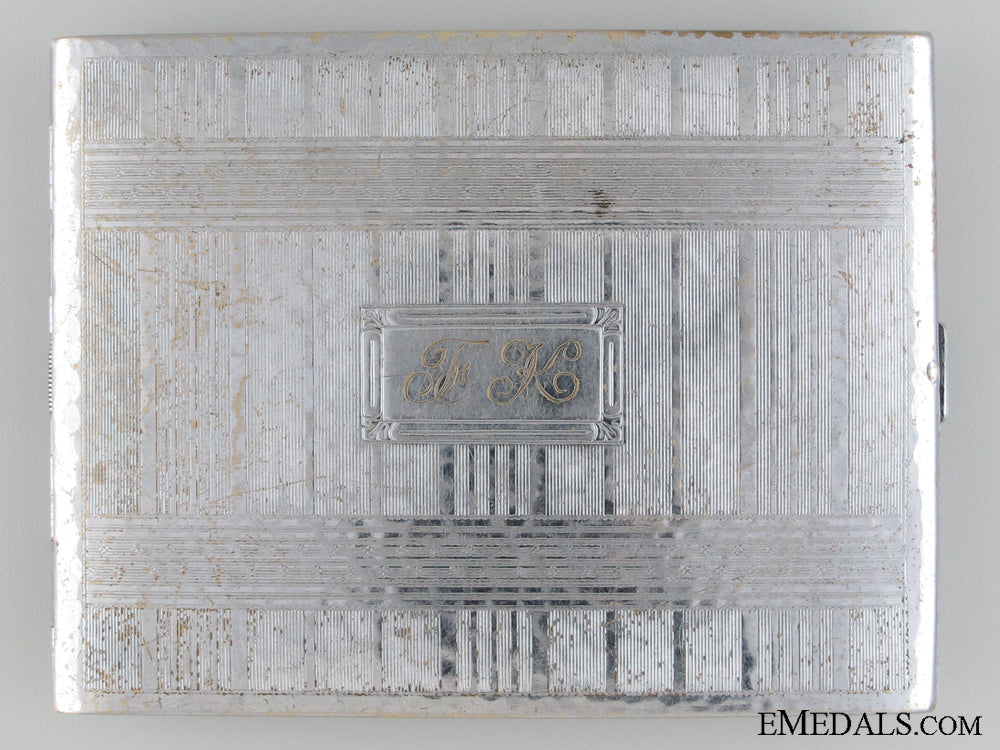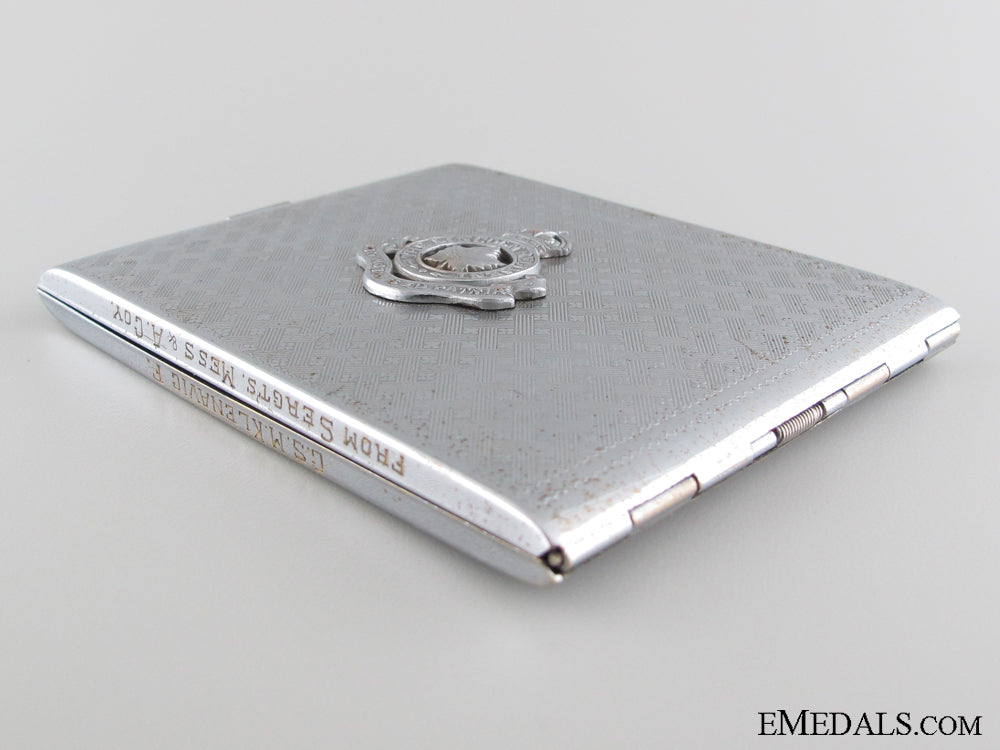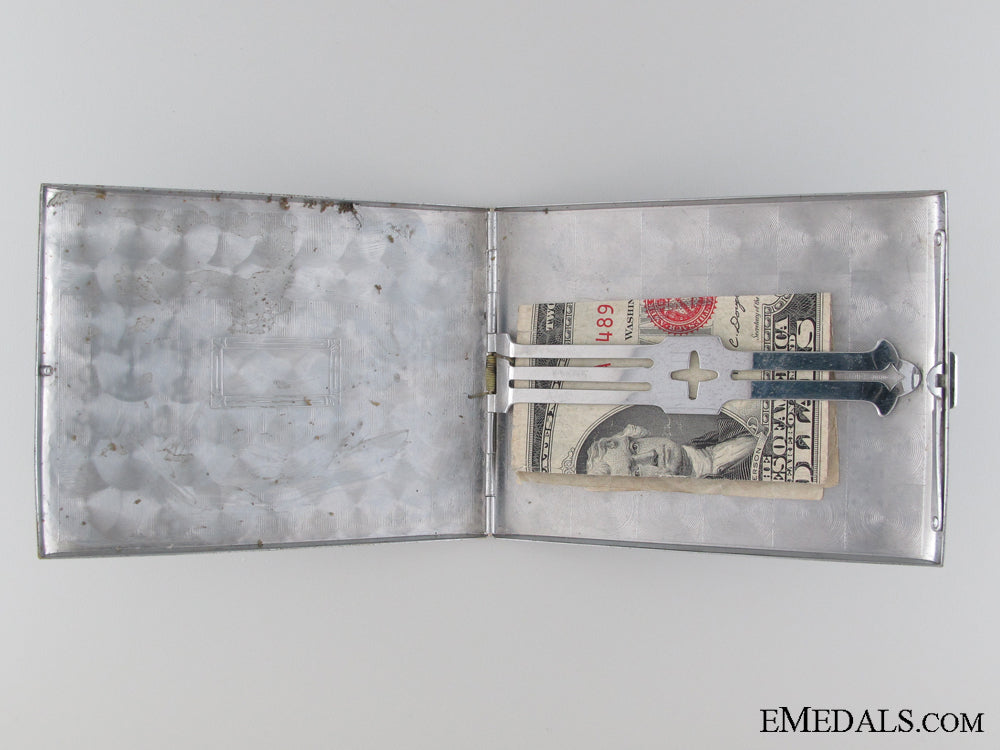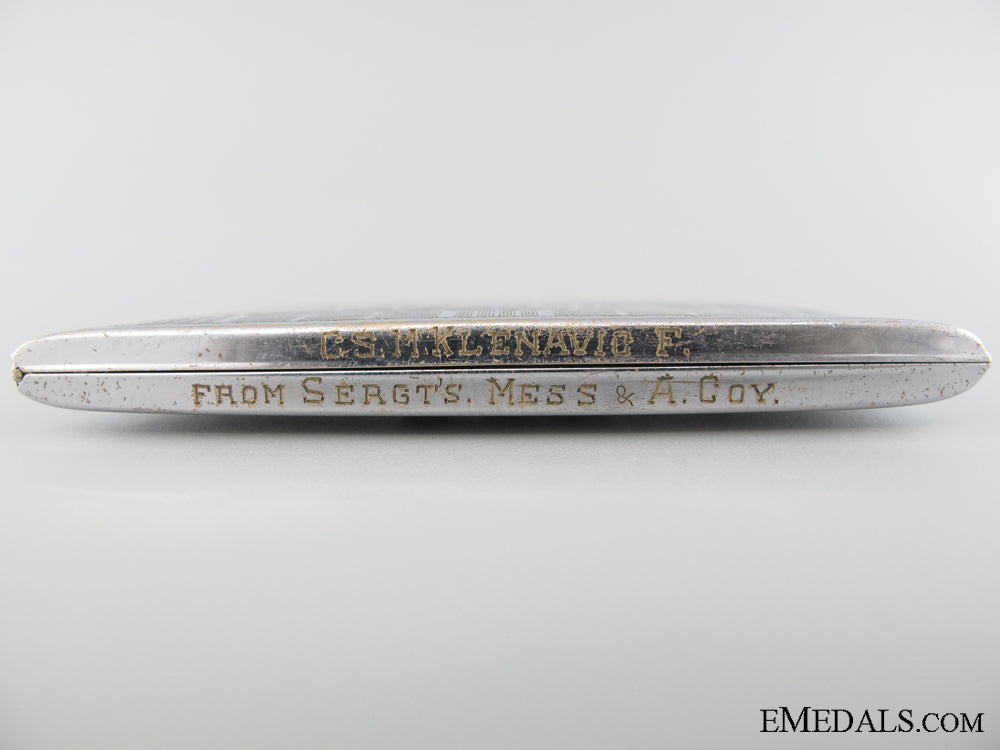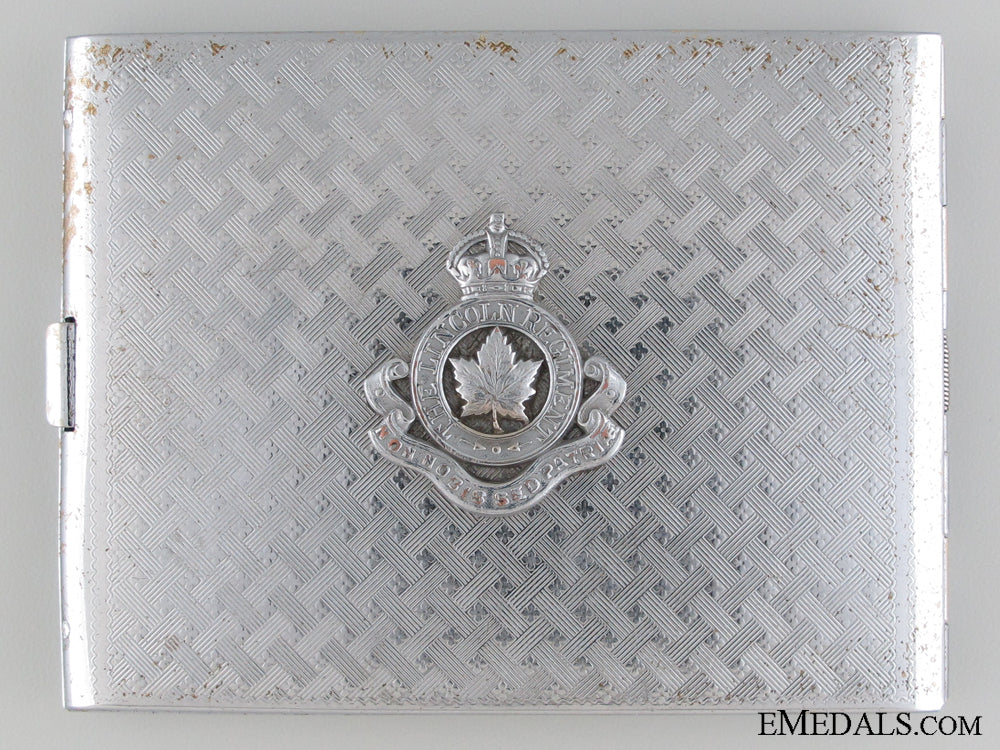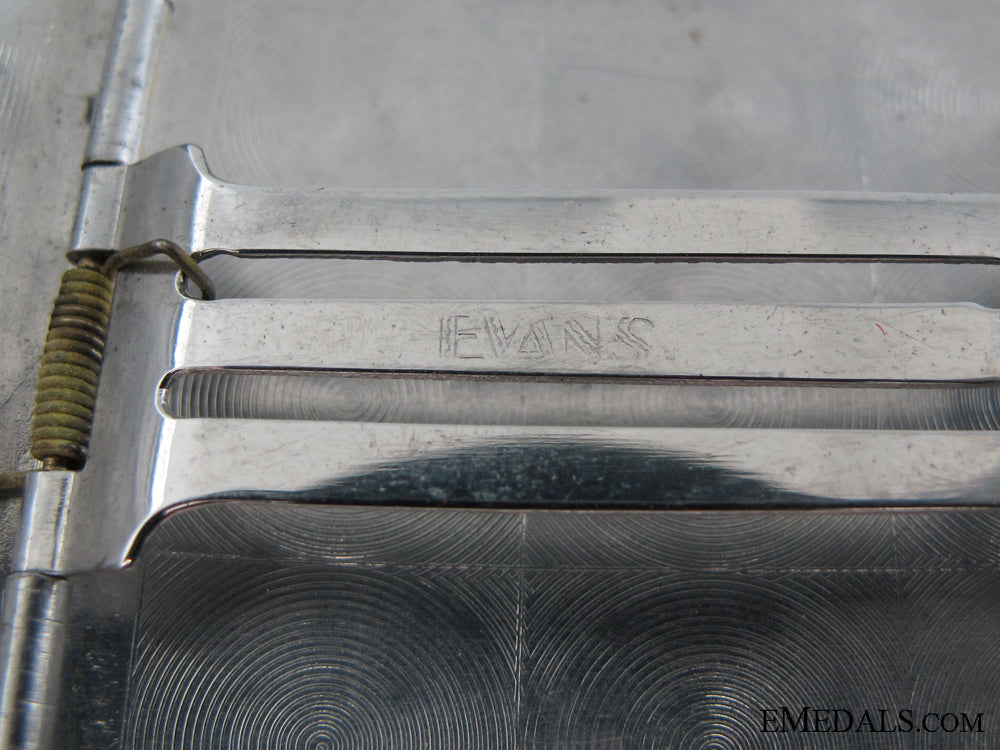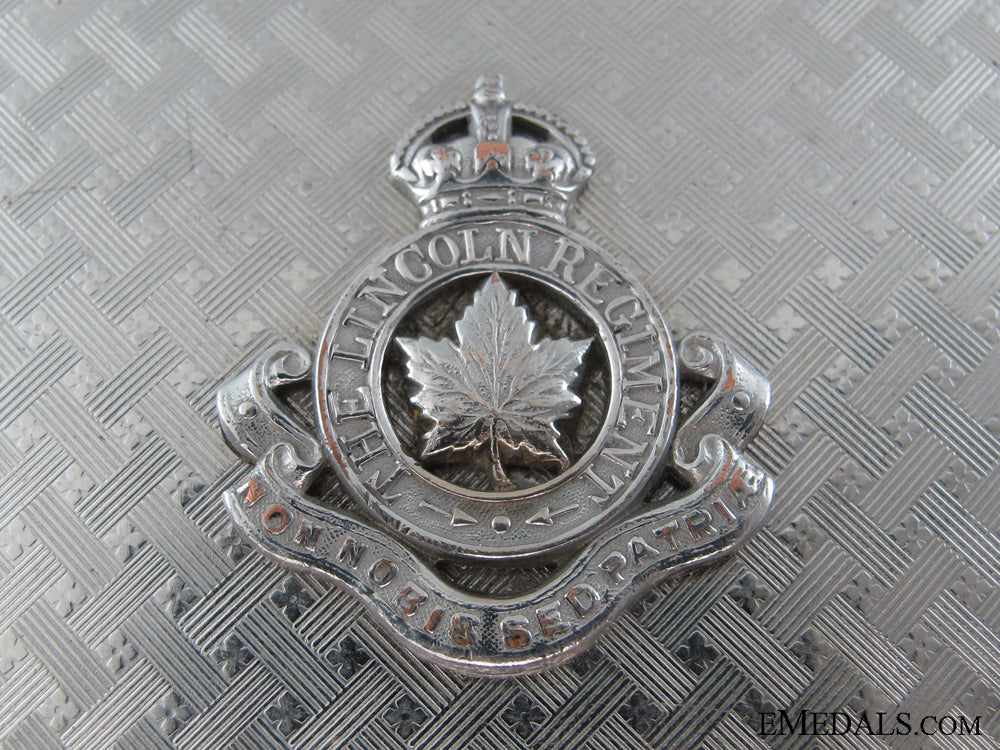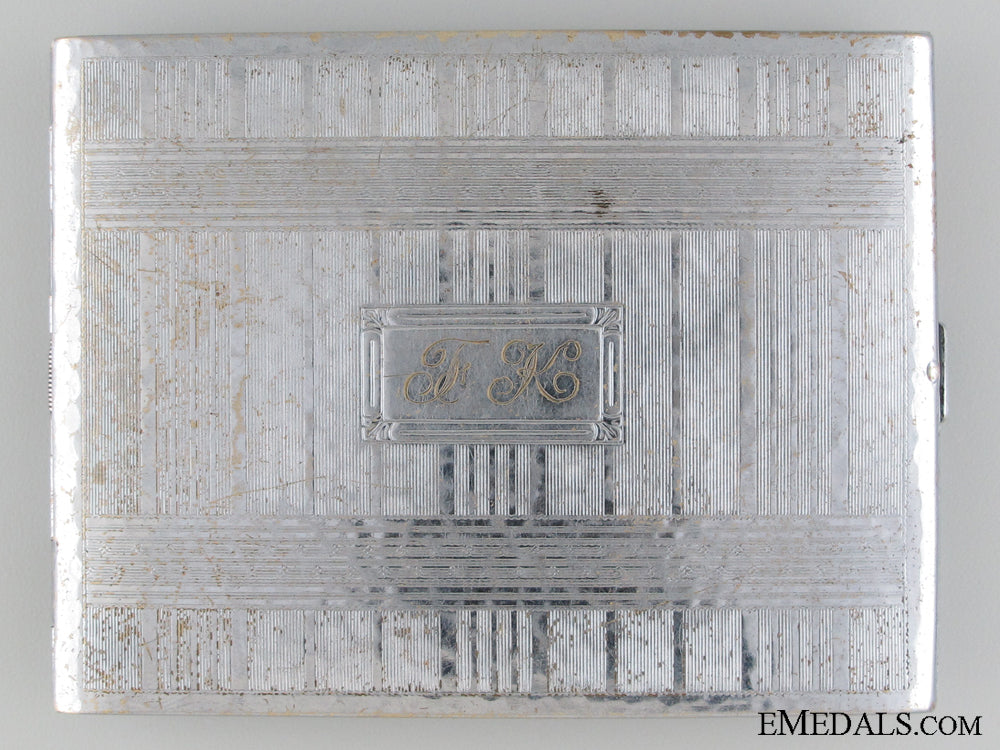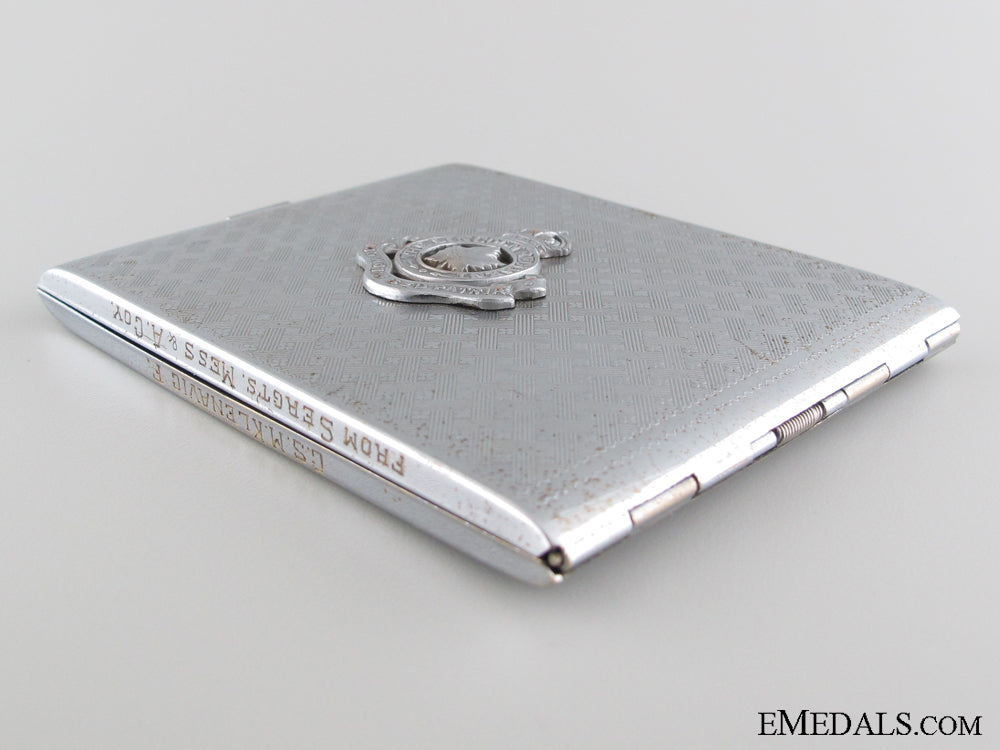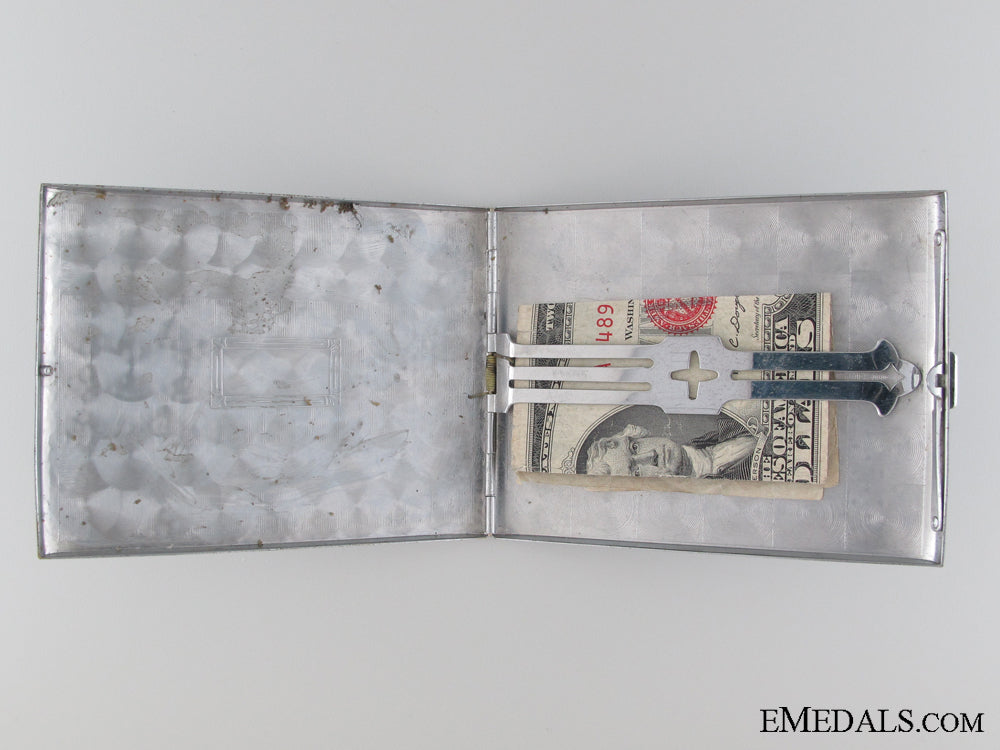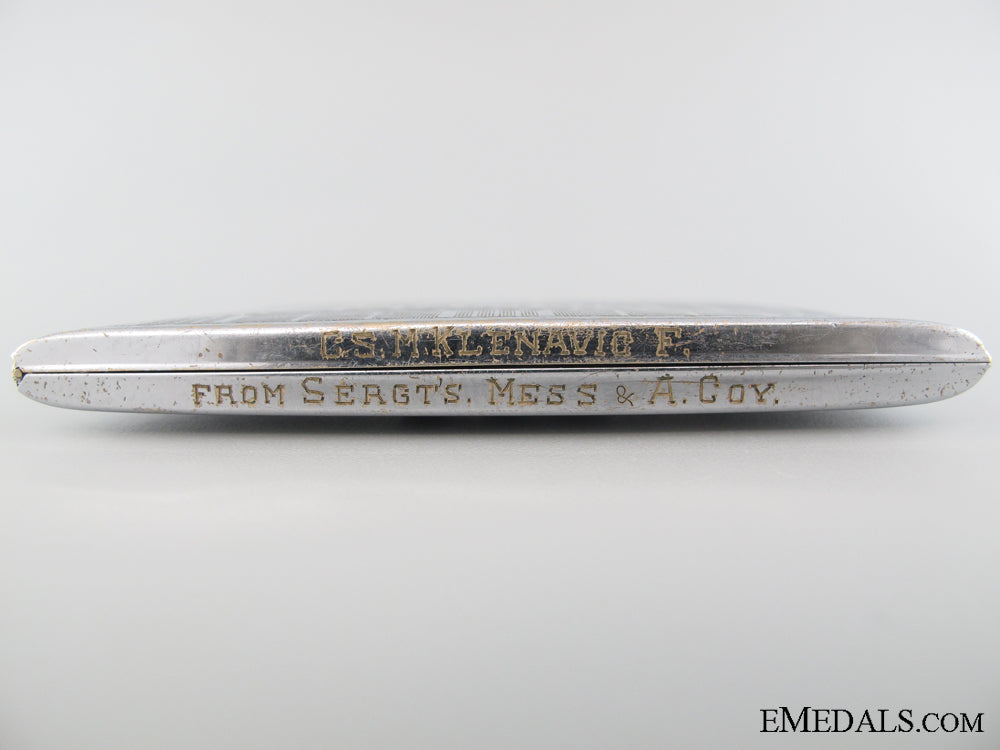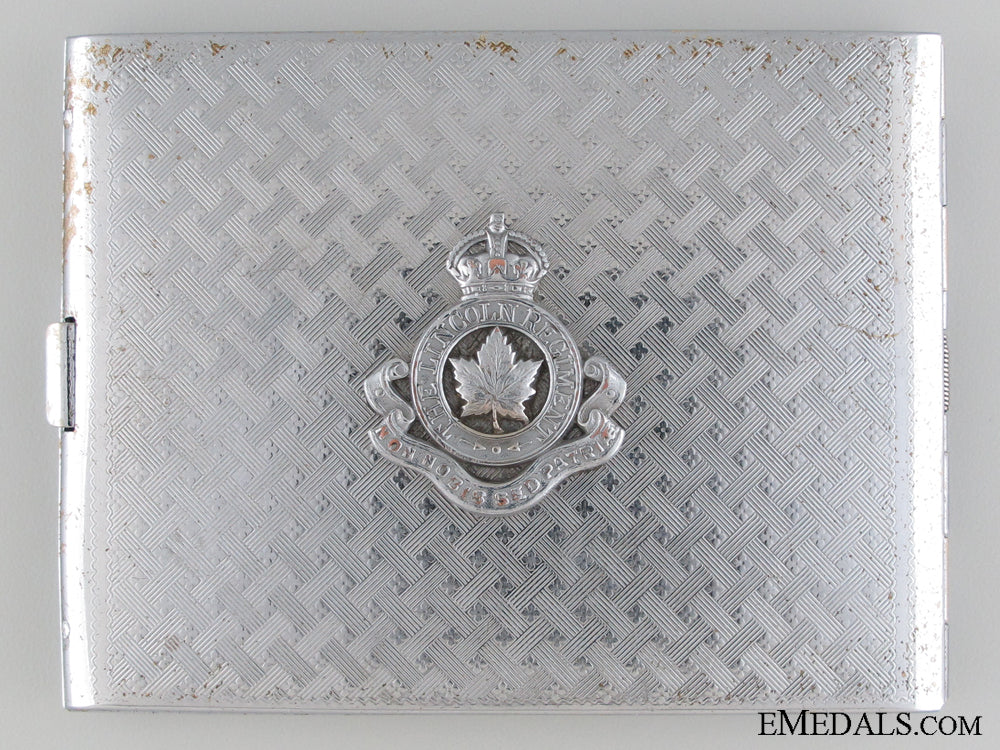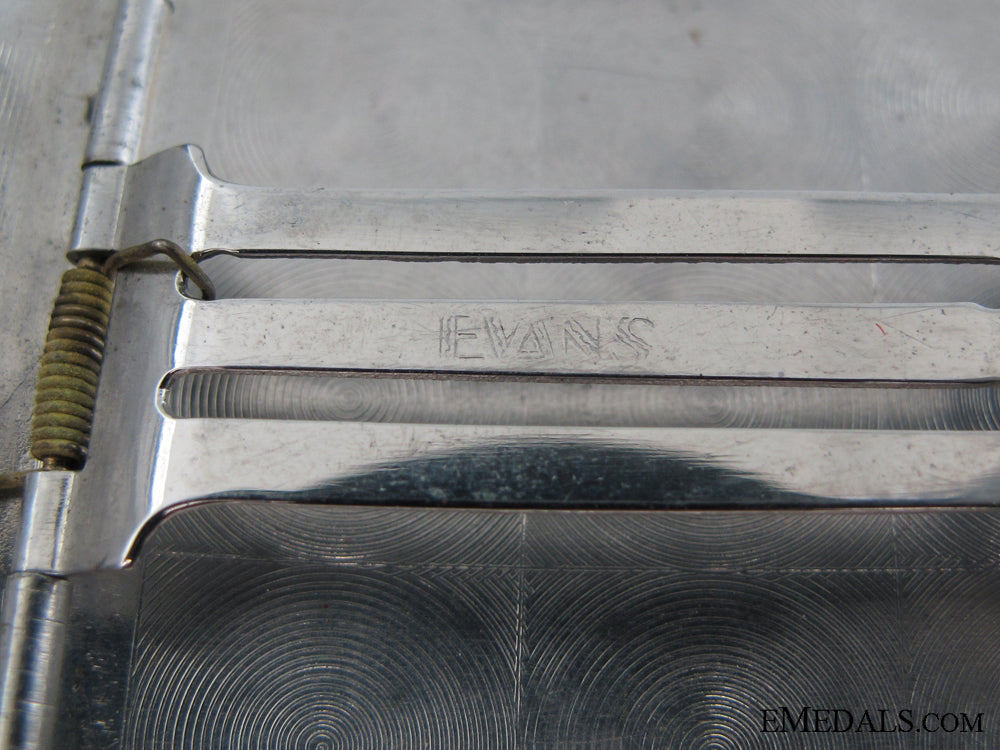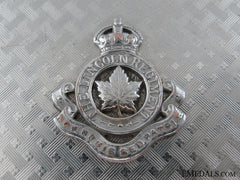Description
Korean War MBE Recipient's Cigarette Case; Defense of Hill 355 -
Cigarette Case (silvered brass, beautifully textured exterior, engraved with the initials "F K" on the front cover, engraved "C.S.M. KLENAVIC F." and "FROM SERGTS. MESS & A. COY." on the bottom edge of the front and back cover respectively, silvered bronze Lincoln Regiment insignia affixed to the back cover, spring-loaded money clip on the inside back cover with a U.S. Two Dollar Bill in place, hinged, push release, 73.5 mm x 96 mm x 12 mm); and Swagger Stick (brown leather wrap on a stiff elongated frame, heavily stitched full-length seam, 16 mm x 615 mm). Light contact on the case, near extremely fine. Accompanied by a copy of the London Gazette 39819, page 1 (datedTuesday, April 7, 1953, naming Major Francis Klenavic (ZP 1751), 1st Battalion, The Royal Canadian Regiment, The Royal Canadian Infantry Corps as a recipient of the Member of the Most Excellent Order of the British Empire (MBE), in recognition of gallant and distinguished services in Korea during the period from July 1 to December 31, 1952).
Footnote: Captain Francis (Frank) Klenavic, Royal Canadian Regiment became the first member of the regiment to see combat in the Second World War, assigned to Tunisia in the North African theatre in 1942. After the end of the war, he returned to Canada but by the early 1950s, he found himself in Korea as part of the Canadian contingent of the United Nations force during the Korean War, better known as a "police action". From a military science perspective, the Korean War combined strategies and tactics of the First and Second World Wars, beginning as a mobile campaign of swift infantry attacks followed by air bombing raids, but became a static trench war by July 1951. Major Francis (Frank) Klenavic was the Deputy Commanding Officer (DCO), commanding the 1st Battalion, Royal Canadian Regiment from October 10 to 25, 1952. It was under his command during the Battle of Kowang-San (AKA the Defence of Hill 355) fought between October 22nd and 24th, that the regiment was to fight its bloodiest and most significant action of the war. On August 10th, the 1st Battalion, Royal Canadian Regiment relieved the 1st Battalion, The Welch Regiment (29th Infantry Brigade), assuming the defence of Hill 355 or Kowang-San as it was known locally. It was also referred to as "Little Gibraltar" by the Americans. It was a dominating feature and a key to the United Nations Line. Control of Hill 355 conferred control of the highways running south to Seoul. To the immediate left of the 1st Battalion, Royal Canadian Regiment was the 1st Battalion, Royal 22nd Regiment and to the right was the 1st Battalion Princess Patricia's Canadian Light Infantry. Over the next three months the 25th Canadian Infantry Brigade would experience the heaviest shelling and mortaring of any period that it spent in the front lines. The Battalion was opposite a junction point in the enemy lines that marked the boundary between the Chinese 39th and 40th Armies (commanded by Generals Xinquan and Yucheng respectively). On August 25th, from the highest point on Hill 355, Company Sergeant-Major Richard McNally of D Company unfurled the Regimental banner, a challenge that sooner or later would be answered by the Chinese. The arrival of autumn brought the end of the monsoon season and a dramatic change in Chinese tactics. They now possessed artillery and mortars in abundance and were increasingly prepared to use these supporting aggressive attacks on United Nations positions. The Chinese would skillfully infiltrate the lines, isolate an outpost and suddenly overwhelm it. Canadian casualties began to mount, though the blood letting was not all one-sided. During a fighting patrol, mounted by Lieutenant H.R. "Russ" Gardner and five men of B Company, including Corporal K.E. Fowler, a Chinese signaller was snatched from an enemy kitchen area, while five other Chinese soldiers were shot dead. The prisoner proved to be from the 346th Regiment, 116th Division, of the Chinese 39th Army. For this action, Gardner was awarded the Military Cross (MC) and Fowler won the Military Medal (MM). On October 1st, the Chinese began a relentless bombardment of Hill 355 that increased rather than decreased in violence as the days passed. Enemy raids and patrols were now probing Canadian main defensive positions on a nightly basis. Kowang-San became so dangerous that American brass stopped visiting it. Chinese prisoners, captured by 1RCR patrols, revealed that an all-out assault on Hill 355 was in the offing. As of October 22nd, Hill 355 was divided into five defensive sectors, each held by one of the five rifle companies of 1RCR (the fifth rifle company, E Company, had only recently been raised, in September). Area 2 lay directly between the main feature of Hill 355 and the Chinese-held Hill 227, less than two miles to the west. It was the closest sector to the enemy and the most exposed. Area 2 was forward-centre in the 1RCR defensive line and had borne the brunt of the Chinese bombardment since October 1st. Area 2 was manned by B Company under the command of Major J.E.L.Cohen. He had deployed his three platoons forward with no company reserve. 4 Platoon commanded by Lieutenant S. MacDonald was on the left and in contact with E Company (Captain H.G. "Herb" Cloutier); 5 Platoon under Lieutenant John Clark was in the centre, and Lieutenant Russ Gardner's 6 Platoon was on the right and in contact with A Company (Major George G. Taylor). D Company (Major R.S. "Bob" Richards) and C Company were dug in depth, left-rear and right-rear respectively, and both available as necessary for counter attack. With battle looming, the Commanding Officer, Lieutenant-Colonel Bingham was on leave and command had devolved on the Deputy Commanding Officer (DCO), Major Frank Klenavic, who commanded the Battalion from October 10th to 25th. At last light on October 22nd, B Company's field defences had been reduced to a deplorable state by the continuing Chinese bombardment. Many bunkers had caved in, most of the reserve ammunition buried and telephone lines cut. With enemy mortar and artillery fire continuing to intensify on Area 2 an attack was anticipated that night. As a result B Company remained at 50% alert throughout the night with one man up in each weapon pit while his partner slept. Chinese sappers worked in close to B Company's positions, destroying wire obstacles with crude bangalore torpedoes. At 1845 hours, a Chinese infiltration group blundered into 4 Platoon's trenches on the left and was shot down to a man. At 2045 hours, A Company, 1st Battalion, The Royal Fusiliers, arrived to take over the defense of Area 5, freeing D Company for a possible counter-move. There was no further contact with the enemy on this night, though the heavy shelling and mortaring continued. By dawn on October 23rd, the situation in Area 2 was precarious in the extreme. All communication with the rear had been cut and enemy shelling had destroyed all of 6 Platoon's bunkers, forcing the soldiers of this platoon to move to their left and take shelter with 5 Platoon. Lieutenant Gardner assumed command of the two combined platoons and Lieutenant Clark acted as a runner to Company Headquarters (HQ) and Battalion HQ to the rear. The weight of Chinese fire kept B Company pinned down during the day; any movement above ground was next to impossible. As a result, neither food nor ammunition could be pushed forward to the beleaguered platoons of B Company. At great personal risk, Lieutenant Clark finally reached Battalion Headquarters and advised Major Klenavic of the desperate situation confronting B Company. The acting Commanding Officer promptly ordered that 5 and 6 Platoons withdraw from their forward positions and re-organize. Major Cohen and Lieutenant Clark made their way to 5 and 6 Platoons to organize their withdrawal. They arrived towards sunset at 1800 hours. At this precise moment the enemy barrage on B Company increased dramatically for ten minutes then rolled on to the rear and flanks. A massive Chinese infantry assault on Area 2 was only minutes away and withdrawal was impossible. Major Cohen and Lieutenants Gardner and Clark and Sergeant Gerald E.P. Enright (5 Platoon Sergeant) hurriedly organized the thirty survivors of 5 and 6 Platoons into some semblance of defense. Blocking positions among the shattered trenches were established and men who had lost their weapons organized into bombing parties. Enemy small arms fire was heavy to their front and large numbers of Chinese began to move in from the flanks. Area 2 was now being attacked by the equivalent of two enemy battalions. On the left, 4 Platoon was overwhelmed, the loss of their position being reported to Major Klenavic by survivors at 1830 hours. On the right, Lieutenant Clark and twelve men stubbornly fought on but were eventually forced to take up a blocking position further to the north where B Company's trenches met A Company's. They were able to hold this position for the rest of the battle, successfully fighting off swarms of Chinese. In the centre, Lieutenant Gardner and another small band of B Company men fought desperately against hundreds of Chinese attacking from the south. On the verge of being overrun, Gardner ordered his men to make for the safety of A Company's trenches. He bravely remained to cover their retreat emptying his automatic carbine at the oncoming Chinese. In this action Lieutenant Gardner was repeatedly hit by enemy fire and eventually went down, but not before he personally shot five Chinese soldiers. He pretended to be dead as hundreds of Chinese moved through B Company's position, ruthlessly bayoneting the bodies of any fallen Canadian soldiers that they found. In the darkness and confusion Lieutenant Gardner was able to crawl to A Company's trenches, dragging with him a wounded comrade. They had been the last Canadians alive in Area 2. By 1943 hours, the news had reached Major Klenavic that there were now no friendly troops left in Area 2. He immediately brought down a fire mission on B Company's former position and ordered every available support weapon in the Battalion, including mortars, machine guns, and recoilless rifles to engage the enemy in Area 2. The heavy and accurate Canadian fire now stopped the Chinese dead in their tracks. Developing enemy attacks at 2100 hours, on A Company in the north and E Company in the south, were broken up by artillery salvoes from 1st Commonwealth Division, including A Battery, 1st Royal Canadian Horse Artillery. By 0110 hours on October 24th, Major Klenavic ordered D Company to counter-attack and drive the Chinese from Area 2. The assaulting platoons from D Company were at first heavily engaged but as they pushed home their attack Chinese resistance crumbled and the enemy evaporated into the night. D Company re-occupied Area 2. By 0330 hours, the Battalion's forward lines had been re-established and the battle was over. The Battle of Kowang-San, fought between October 22 and 24, 1952 had lasted 33 hours. In that period 1RCR had suffered 18 killed, 14 missing, and 35 wounded. Enemy casualties were unknown but believed extremely heavy. In fact, in the aftermath of the battle, helicopter observers counted up to six hundred Chinese bodies scattered across the battlefield. As a result of the action at Kowang-San soldiers of the Battalion won three Military Crosses and four Military Medals for gallantry. The Military Crosses were won by acting Major George Taylor, OC of A Company; Captain Cloutier, commanding E Company; and by Lieutenant Clark of 5 Platoon, B Company. It is also worth noting that for his sterling service as the Forward Observation Officer (FOO) during the battle, Captain D.S. Caldwell was also awarded the MC. Sergeant Enright, also of 5 Platoon, was one of the recipients of the Military Medal (MM), as was Warrant Officer 2nd Class (WO2) George Fox, CSM of E Company. At the conclusion of the Battalion's tour in Korea, Lieutenant-Colonel Bingham would be awarded the Distinguished Service Order (DSO), in recognition of the outstanding achievements of 1RCR over the past eleven months. The defence of Hill 355 had been the bloodiest and most significant action fought by the 1st Battalion, The Royal Canadian Regiment during its eleven month combat tour in Korea. For his strong leadership throughout the battle, Major Francis Klevanic (ZP 1751), 1st Battalion, Royal Canadian Regiment, The Royal Canadian Infantry Corps was awarded the Member of the Most Excellent Order of the British Empire (MBE), "in recognition of gallant and distinguished service in Korea during the period 1 July to 31 December, 1952", as mentioned in the London Gazette 39819, page 1, dated Tuesday, April 7, 1953. As a Captain and Acting Major, he had been Mentioned in Depatches, and as a Major, was to be a Serving Brother to the Venerable Order of the Hospital of Saint John of Jerusalem.

